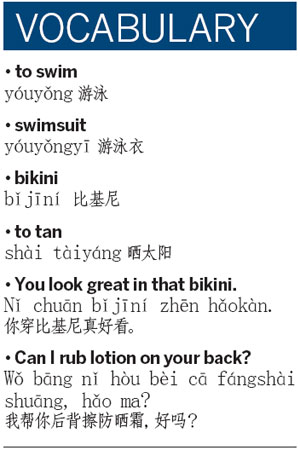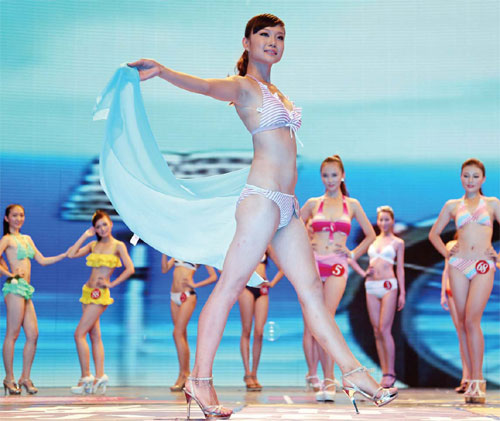From bubble suits to bikinis
Updated: 2012-08-24 09:17
By Ginger Huang (黄原竟) (China Daily)
|
|||||||||||
|
Candidates wearing bikinis compete at the Miss Shaanxi contest in August. Yuan Jingzhi / For China Daily |
Changes in china reflected in 40 years of swimwear
On July 16, 1976, Huang Yang and his classmates left school and walked to the Xunbila River. They were not just skipping school. They had a purpose. On that day, thousands of people all over China were doing the same thing: swimming.
Five thousand people in the city of Wuhan alone paraded to the Yangtze River. They were soldiers, factory workers and students, and they all swam. The water surface was adorned with red flags and banners.
The soldiers, holding their guns above their heads, swam in uniform and turned their pockets inside out so they would not fill with water.
Similar celebrations took place in all swimmable waters across the country, from the Pearl River in southern China's Guangdong province to the Kunming Lake in Beijing's Summer Palace.
These aquatic celebrations commemorated Mao Zedong's final swim in the Yangtze River, on July 16, 1966, when he was already 73 years old. At that point, he was still the most influential swimmer in China.
In 1956, he famously swam across the Yangtze River three times, a feat immortalized in his heroic poem:
"However hard the wind blows and the waves hit, I feel like I'm taking a casual walk in a peaceful courtyard."
Bùguǎn fēng chuī làng dǎ, shèngsì xián tíng xìnbù.
不管风吹浪打,胜似闲庭信步。
"Swimming is a sport that fights the power of nature," he said. "We should all exercise in rivers and seas." After hearing this declaration, everyone swam. It meant you were brave, that you could endure hardships, and also that you had a great, revolutionary spirit.
Some of these inspired, patriotic swimmers jumped into the water, wearing nothing at all. (At least the men, that is.) Back then, swimsuits were expensive.

Gu Qing was one of those red-blooded youngsters who loved swimming. He recalled that most men, if they wore anything, wore just underwear. Very few envied individuals were wearing blue, oddly-shaped, triangular swimsuits.
For those who could not afford a pair of genuine blue swimsuits, they turned to another material, one that was readily available - Young Pioneers' red scarves. A makeshift swimsuit was made of two scarves sewn together, with a knot on the right side.
In the 1960s, most women's swimsuits were made of thick, stiff cotton. It was not very comfortable, or popular. The design changed when a thinner, more flexible style was introduced in the early 1970s. These suits were outfitted with "bubbles" (泡泡泳衣 pàopào yǒngyī), tiny rubber bands sewn in. They made the swimsuits somewhat elastic, but still quite heavy when wet. All of these suits were either in red or blue. As a result, looking for your friends in a beach crowd could be pretty hard - everyone looked the same.
In the 1980s, amid the sweeping economic reforms, new technology and textiles were imported. The latest swimsuits made use of these new materials, and Chinese women could finally get rid of their heavy, ridiculous bubble swimsuits. But not everyone was eager to.
Some of the new suits, many felt, were too revealing. They actually showed women's curves - and this was a new thing.
For years, Chinese women had been working alongside men as equals. During Mao's time, women cast aside their traditional gender roles. Men and women would wear the same clothes, and take on the same tasks. "Women support half the sky," Mao had said. During this time, showing too much of your body was thought to be "too Western".
This is why, years afterwards, most people were still more comfortable
in their wrinkled, concealing swimsuits.
But then came 1986, which changed everything. This was to be remembered as the "bikini year".
In that year, China became a member of the International Federation of Body Building. Prior to 1986, athletes wore one-piece swimsuits during the contests. However, according to Federation rules, female contestants had to be dressed in bikinis. This would allow judges to best evaluate the quality and tone of the contestants' muscles.
Though the National Sports Bureau asked the Chinese athletes to dress in bikinis, local organizing committee members were afraid to upset the status quo. Across the nation many meetings were held discussing this. Still, the matter resulted in indecision. Would they wear bikinis?
Finally, four Guangdong women made the move. These bodybuilders were trained under a private coach - Xiong Guohui, who owned his own gym.
Citizens were horrified. Some of the contestant's parents even threatened to disown their daughters. And after the first show, someone called the Public Security Bureau, calling the competition "pornography".
China was changing. For whatever reason, maybe wanting to project a more international and liberal image, the Administration of Sports ultimately supported Yuan and his bikini-clad athletes.
The bikini had made its way into China, 40 years after its invention in France. The event was even included in the Top 10 Breaking News Stories of the Year.
In 1989, Beijing's first karaoke club opened, and within a year, the KTV trend exploded. Small music companies would shoot their own unauthorized low-budget music videos, and most of these took place on beaches. They usually featured a young woman, in a bikini. Her hair would be in the latest style, her scarf would be waving in the tropical wind, and maybe she'd be flirting with a tanned man under coconut trees.
We were not looking at the women of Mao's era, "supporting half of the sky". They were not coal miners or metal welders wearing work clothes. They were not wearing cotton one-piece swimsuits either. They had become objectified.
That is when we knew that times had really changed.
Courtesy of The World of Chinese, www.theworldofchinese.com
The World of Chinese
(China Daily 08/24/2012 page27)
Today's Top News
Rescuers race against time for quake victims
Telecom workers restore links
Coal mine blast kills 18 in Jilin
Intl scholarship puts China on the map
More bird flu patients discharged
Gold loses sheen, but still a safe bet
US 'turns blind eye to human rights'
Telecom workers restore links
Hot Topics
Lunar probe , China growth forecasts, Emission rules get tougher, China seen through 'colored lens', International board,
Editor's Picks

|

|

|

|

|

|






